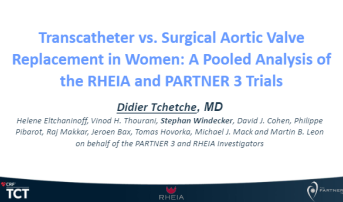Pooled All-Female Analysis Support Benefits of TAVI Over SAVR
Fewer rehospitalizations and better functional and QoL outcomes point to TAVI as a good choice, but longer-term data are needed.

WASHINGTON, DC—In women with symptomatic severe aortic stenosis (AS), TAVI yields better outcomes at 1 year compared with surgery, with no differences by annular size or age, according to a large all-female pooled analysis.
Rates of the composite endpoint of all-cause death, stroke, or rehospitalization at 12 months were 16.8% versus 8.5% (P < 0.001), for surgery and TAVI, respectively, Didier Tchetche, MD (Clinique Pasteur Toulouse, France), reported here at TCT 2024. The difference was driven by rehospitalizations, which occurred at a rate of 11.9% for surgery patients and 5.4% with TAVI (P = 0.002).
To TCTMD, Tchetche said building a female-specific evidence base for the treatment of symptomatic severe AS is both essential and timely.
“Women are at the same degree of aortic stenosis [risk] . . . compared to men, but in most of the trials, they [account for] barely 30% of the population. They are underdiagnosed, that's a given. They are undertreated, [and] by the time they come to surgery, it's often too late, with some cardiac damage,” he said.
Another important consideration, said Tchetche, is that surgery may be challenging due to anatomy or geographic availability, so access to TAVI could make the difference between getting treated or not.
RHEIA was the first RCT comparing TAVI and SAVR exclusively in female patients. The 1-year outcomes, which were presented recently at the European Society of Cardiology Congress 2024, showed that the primary composite endpoint of all-cause mortality, stroke, or rehospitalization for valve- or procedure-related symptoms or worsening of heart failure was about 45% lower with TAVI, meeting criteria for both noninferiority and superiority. However, the trial exclusively used the third-generation balloon-expandable Sapien 3 or Sapien 3 Ultra valve (Edwards Lifesciences).
RHEIA landed while the structural heart community was still digesting the SMART trial, which included 90% women. Presented earlier this year, SMART showed that women with small aortic annuli seem to have better hemodynamic outcomes at 1 year if treated with a self-expanding Evolut PRO/PRO+/FX valve (Medtronic) as opposed to a balloon-expandable Sapien 3/3 Ultra.
Combining RHEIA and PARTNER 3 is helped by the fact that the trials had the same primary endpoint of all-cause death, stroke, or rehospitalization, Tchetche noted.
In a press conference prior to the presentation, Sonia Petronio, MD (University of Pisa, Italy), echoed Tchetche’s statement about the timeliness of data focused specifically on how to treat women with severe AS.
“Women have small annulus and . . . it is not easy to go through a surgery with a person with a small annuli. So, the importance of this study is that it is a good option, probably the best one for an elderly woman,” she said.
But during the main arena session, discussant and cardiac surgeon Gorav Ailawadi, MD (University of Michigan, Ann Arbor), disputed that, pointing out that refinement of surgical techniques for small annuli has continued.
"We're now experiencing a lot more data and [understanding] things that we can do in surgery to get better [effective orifice areas], whether it's a total root replacement or an enlargement," he said. Moreover, in the PARTNER 3 trial, the percentage of patients who got a root enlargement in the surgical group was low and that it was "essentially" none in RHEAI.
Indeed, the slides presented by Hélène Eltchaninoff at ESC indicate that the rate of concomitant aortic annulus enlargement in the RHEAI patients undergoing SAVR was 0%.
To TCTMD, Ailawadi said more data is on the way. "We have studies coming out comparing surgical AVR with annular enlargement versus TAVR specifically in women and we are seeing some interesting and contrary findings to this study."
Tchetche, during the session, said that a root enlargement must be "applied appropriately because it's pretty challenging," adding that if it can be done, “newer surgical devices may achieve good hemodynamics."
RHEIA and PARTNER 3 Combined
For the pooled analysis, the researchers looked at 30-day and 1-year clinical and echocardiographic outcomes in 376 patients randomized to TAVI and 336 randomized to surgery with any commercially available surgical valve.
The mean age was 73 years, with a mean STS score of 2.1% and mean EuroSCORE II of 1.7%. The mean annular area on CT was 406.7 mm2 in the TAVI group and 408.7 mm2 in the surgery group. Approximately one-quarter of the population had diabetes. CAD was present in 15% of the TAVI group and 18% of the surgery group.
The most common valve size used in the TAVI group was 23 mm, with the largest size (29 mm) used in just 2.9% of the cohort. In the surgery group, 23 mm and 21 mm valves were used in approximately 80%, with the largest size (27 mm) used in just 0.6%.
Among secondary outcomes, 23.6% of patients in the surgery arm had new-onset atrial fibrillation at 1 year compared with 4% of the TAVI group. Women randomized to surgery also had more life-threatening or major bleeding at 1 year than those randomized to TAVI (16.7% vs 3.5%).
Additionally, while there was a slightly higher incidence of mild regurgitation in the TAVI group, more than 99% of patients in both groups had none/trace or mild regurgitation at both 30 days and 1 year.
Reassuringly for a small annuli population, Tchetche showed that more than 74% of patients in both groups had no significant patient-prosthesis mismatch at 30 days.
Compared with TAVI, surgery resulted in a difference in gradients of 2.5 mm Hg that was statistically significant and favored surgery.
Hemodynamics and gradients in women with small annuli have been a topic of increased interested since SMART suggested that self-expandable valves might be the best option in a predominantly female cohort.
In the press conference, Tchetche said the gradients in the pooled analysis are “still reasonably low given the small annuli population.”
Other findings of the analysis were that 97.7% of TAVI patients and 96.8% of surgery patients were NYHA class I/II at 1 year and that quality of life as measured by the Kansas City Cardiomyopathy Questionnaire was better with TAVI for the first year, with the curves seemingly converging around 12 months.
Discussant Stefan Blankenberg, MD (University Heart and Vascular Center Hamburg, Germany), who was the lead author of the DEDICATE-DZHK6 trial showing TAVI was noninferior to SAVR in low- or intermediate-risk patients, said he was reassured that the CT-derived mean annular size in women in that trial was very close to that seen in both PARTNER 3 and RHEIA.
“We are all thinking about which medical device and how do we treat women and men according to the anatomical issues we observe,” Blankenberg stated. That being said, he wondered how these data can be used to help physicians making treatment decisions.
Tchetche said knowing that TAVI is associated with early hospital discharge, a low risk of rehospitalization, and functional and quality of life improvements should help reassure that TAVI is a good first choice for many women but acknowledged that data beyond 1 year are needed.
Blankenberg noted that despite the relative equivalence of the two pooled RCTs, a random-effects analysis might better control for variations across regions, centers, and patient populations.
“Initially when we discussed the methodology of the analysis that was one of the concerns that we had, but we were extremely well reassured, because if you go into the definitions, the description of the primary endpoint and even the occurrence of the primary endpoint between TAVR and surgery in both trials [is] superimposed,” Tchetche said.
Ailawadi also asked about duration of follow-up for this pooled cohort. The mean age of the female patients in the trial was 73, raising questions of valve durability. Tchetche, in response, said the ability to do that for a pooled analysis like this one is uncertain, given the additional funding required.
To TCTMD, Ailawadi, stressed that a declaring a win for TAVI with just 1 year of follow-up in these female patients "really isn't fair" to the patient.
"Nearly all TAVR versus SAVR trials have shown better outcomes in the short term (1 year), but we are starting to see some differences between 4 and 5 years in some of the trials," he said. "A final point to make is that women who eventually end up needing TAVR explant have much higher mortality than men. I believe this is due to the small root and it’s not clear to me that low risk women should get TAVR as the first strategy if we are thinking longer term."
L.A. McKeown is a Senior Medical Journalist for TCTMD, the Section Editor of CV Team Forum, and Senior Medical…
Read Full BioSources
Tchetche D. Transcatheter vs surgical aortic valve replacement in women: a pooled analysis of the RHEIA and PARTNER 3 trials. Presented at: TCT 2024. October 29, 2024. Washington, DC.
Disclosures
- Tchetche reports consulting fees/honoraria from Abbott Vascular, Boston Scientific, Edwards Lifesciences, Medtronic, and Venus MedTech.
- Blankenberg reports consulting fees/honoraria/speaker’s bureau fees from Abbott, Amgen, AstraZeneca, Bayer AG, Bristol Myers Squibb, Boehringer Ingelheim, Daiichi Sankyo/Eli Lilly, GSK, Lumira DX, Novartis, Roche Diagnostics, and Thermo Fisher.






Comments